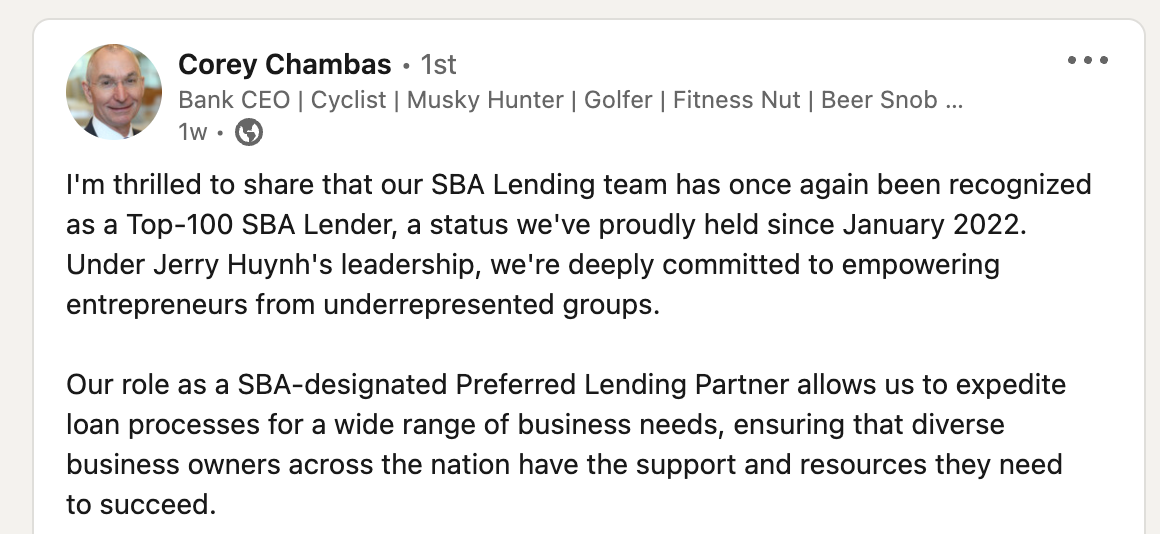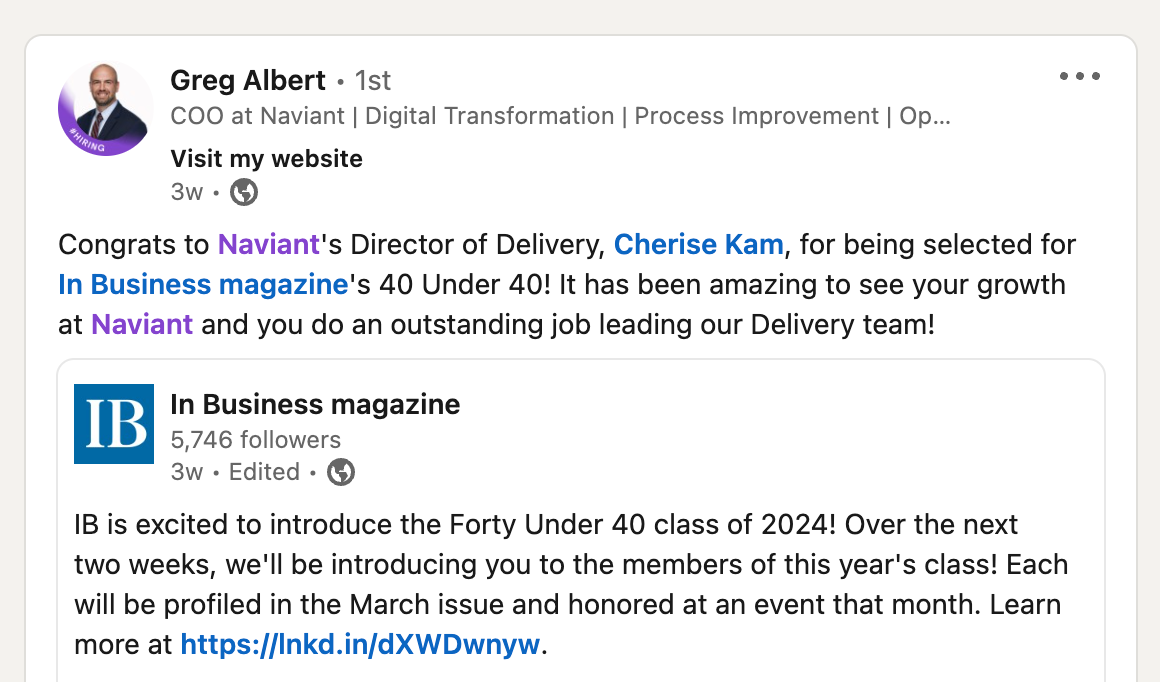How Senior Leaders Can Support a Social Strategy

An active LinkedIn presence is more than a personal asset—it's a strategic advantage for companies aiming to amplify their brand, attract top talent, and foster industry connections.
Recognizing this, many businesses should encourage their team members to harness the power of social selling, not just for networking, but as a platform for thought leadership and content creation.
However, despite this enthusiasm, organizations often find themselves at a crossroads, struggling to effectively support and motivate their team to engage meaningfully on the platform. Or vice-versa, employees find themselves unsupported by senior leadership in their social strategy.
This gap between intention and action means that both individuals and their companies miss out on the substantial benefits of an active social and content strategy.
In this week’s Sell with Social, we’ll dive into ways senior leadership can help support their team with their digital and social selling efforts. We'll outline strategic solutions for leadership to not only encourage but empower their teams to embrace LinkedIn as a tool for personal and professional growth.
Why Businesses Should Support a Social Strategy
In our digital world, where professional networking, personal branding, and thought leadership increasingly dictate market dynamics, the strategic importance of LinkedIn cannot be overstated.
For business leaders looking to secure a competitive edge, encouraging their team to actively engage on LinkedIn is not just beneficial; it's essential.
Here are compelling reasons why leaders should prioritize LinkedIn activity within their teams:
Enhanced Company Visibility
When team members are active on LinkedIn, they collectively amplify the company's visibility. Each share, post, or comment acts as a beacon, drawing attention not only to the individual's expertise but also to the organization's presence and thought leadership in the industry. This aggregated visibility can significantly boost the company's brand awareness, attracting potential clients, partners, and talent to the organization.
Personal Branding as a Reflection of Company Strength
The personal brands of employees are reflections of the company's strength and diversity. Encouraging team members to build strong personal brands on LinkedIn showcases the depth of expertise within the company, reinforcing its reputation as a leader in its field. When employees are recognized as industry experts, it elevates the company's standing, making it more attractive to stakeholders across the board.
Attracting Talent through Employee Advocacy
In today's competitive job market, potential candidates often look to a company's employees as the most authentic source of information about the work culture and opportunities. An active presence by team members on LinkedIn can serve as a powerful form of employee advocacy, showcasing the company as a dynamic and engaging place to work. This not only helps attract top talent but also retains it by fostering a culture of pride and belonging.
Networking and Opportunity Building
LinkedIn provides an unparalleled platform for networking and relationship building. By actively engaging on LinkedIn, team members can connect with peers, industry leaders, and potential customers, opening up avenues for collaboration, knowledge exchange, and new business opportunities.
Most importantly, leaders need to recognize that embracing a social strategy is part of digitally transforming your business. This is how business is done today. Failing to recognize that will only cause you to fall behind your competitors in the marketplace.
10 Strategies For Senior Leaders to Support a Social Strategy
So what can senior leaders do to support a social strategy with their team?
It starts with intentionality. You need to make social selling a strategic priority for your team, especially on the sales and service side of your business.
Once the broader direction is set, then you need to actually implement the strategy throughout your organization. Here are ten ways you can do that:
1. Lead by Example
Leadership engagement on LinkedIn sets a powerful precedent. By actively participating in social networking themselves—sharing company news, industry insights, and recognizing team achievements—senior leaders can demonstrate the value they place on LinkedIn as a tool for professional and organizational growth. Their active presence can inspire and encourage team members to follow suit.

2. Publicly Acknowledge and Reward Efforts
Implementing a system of recognition for employees who actively contribute to the company's presence on LinkedIn can significantly boost motivation. This could take the form of shout-outs in company meetings, feature articles in internal newsletters, or even performance incentives. Public acknowledgment shows that the leadership is paying attention and appreciates the efforts being made.
3. Incorporate LinkedIn Activity into Professional Development Goals
Making LinkedIn engagement part of the professional development goals for employees underscores its importance from a strategic perspective. When employees see that their efforts on LinkedIn are recognized as part of their contribution to the company's success and their professional growth, it legitimizes and motivates further engagement.
4. Provide Strategic Direction and Support
Offering support for LinkedIn activities can help employees align their efforts with the company's strategic goals. This could include workshops on personal branding, content creation, or how to network effectively on LinkedIn. Providing this support demonstrates that leadership not only encourages LinkedIn engagement but is also invested in helping employees succeed in these efforts.

5. Encourage the Sharing of Success Stories
Creating opportunities for employees to share their LinkedIn success stories—whether it's connecting with a key industry figure, contributing to a thought leadership piece, or engaging in meaningful conversations—can be incredibly motivating for the entire team. It shows that individual efforts have tangible outcomes and that the company values these contributions. These are great in team meetings or even just internal messenger groups.
6. Facilitate Access to Tools
Provide team members with access to premium LinkedIn features, such as Sales Navigator, depending on their role and needs. This tangible support not only equips employees with tools to enhance their LinkedIn presence but also signals the company's investment in their professional growth on the platform.
7. Create a Digital Mentorship Program
Establish a mentorship program where experienced LinkedIn users within the organization mentor those less familiar with the platform. This peer support system can help spread best practices, encourage more active engagement, and reinforce the importance of LinkedIn activities as recognized by leadership.
8. Leverage LinkedIn for Internal Communications
Use LinkedIn not just for external communication but also as a platform for celebrating internal milestones, achievements, and employee spotlights. When leadership uses LinkedIn to highlight team members' accomplishments, it underscores the platform's importance and encourages others to actively participate.

9. Develop Content Ambassadors
Identify and support a group of employees to become content ambassadors on LinkedIn. These individuals can lead by example, creating and sharing content that aligns with the company’s goals and messaging. Providing training and resources to these ambassadors can help elevate the quality and consistency of content shared, fostering a culture of excellence in LinkedIn engagement.
10. Take a Long Term View
Build social media engagement into your long term company strategy. Make it clear that you are not expecting to make this a one-and-done approach, but instead an integral part of how you expect to grow your business going forward. Look at results in terms of months or years, not days and weeks.

This week’s action items will be different depending on your role within your organization. Either way though, there is work to be done!
If you’re in a leadership position, here are your weekly action items:
- Review Your Social Strategy - Start by reviewing your social strategy. Do you have one? Have you communicated it? Work with your colleagues to get the foundations in place.
- Execute with Intention - Next, you need to actually implement your strategy. Take a look at the ten ideas above in this article for inspiration on ways you can start to take action to execute your social strategy.
- Analyze and Iterate - On a regular cadence (I’d recommend monthly or quarterly), you should be analyzing the results of your social strategy. What is working? What is not working? Iterate and improve your strategy by working with key stakeholders on your team.
If you’re not in a leadership role, here are your weekly action items:
- Set the Example - Start executing your own social selling strategy and set the example for your organization. Show them how individuals can expand their reach and build authority using digital channels and social networks.
- Share Your Success - Actively communicate your success with your team. Share stories as you grow your personal brand, expand your professional network, and uncover opportunities that lead to business results.
- Become a Mentor - If there are others in your organization who have expressed interest in your strategy, actively encourage them through mentorship. Show them how you’ve grown and share tactical tips to help get them started.
